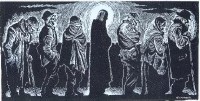

Karen House Catholic Worker
 |
Karen House Catholic Worker |
The RoundTable East St. Louis: Hope in Hard Times Summer 1989
Major Articles
|
Download Entire Issue by Clicking Image Above (large file - it takes a minute!) |
|||
Karen House: 1840 Hogan St. Saint Louis, MO 63106 Contact Us: 314.621.4052 |
Regular Features
|
Why This Issue: Just as today corporations flee to Brazil, Korea and Taiwan where labor and resources are cheaper, around the turn of the century they flocked to cities such as East St. Louis and its surrounding environs. Cheap and plentiful land lured the stockyards and the railway yards and terminals away from St. Louis to the east side. A cheap coal supply drew the steel foundaries, the iron and aluminum manufacturers and the packing plants. Of course, the workers who were to toil in these plants soon followed. East St. Louis' population jumped from 15,000 in 1890 to 70,000 in 1912. The communities of Granite City and Madison sprung up both to house and separate the Bulgarian and Macedonian immigrants, among others, from the African-Americans arriving from the South. The influx of the latter group was enormous. In a single four month period in 1912 the black population of East St Louis shot up from 12,000 to 20,000. Many of these laborers had been railroaded into the city to be used as strikebreakers. This laid the ground for the worse race riot in our country's history. For 10 days in 1917 white citizens hunted down and brutally massacred men, women and children of African descent, laying bare the economic roots of racism.
The communities on the east side of the Mississippi have endured years of economic and racial oppression. This issue, however, is not a litany of complaints and struggles. Instead it illustrates the truth of S1. Paul's words that the sufferings we endure will teach us patience and perseverance, that these virtues bring hope and that this hope is not deceptive. His point was not to glorify suffering, but to redeem it. The articles in this issue reveal that although the east side is economically poor, it is spiritually very rich, for hope has had fertile ground in which to grow. Judge Milton Wharton offers his perspective on the roots of crime and the need for community. Sister Julia Huiskamp lists the environmental abuses which the east side has had to suffer. High school students at East St Louis Senior High voice their concerns and dreams and tell us not to be afraid of their city. Joe Angert provides photographs of the city. In addition to our house articles, Bill Miller presents a review of Jonathan Kozol's book, Rachel and Her Children: Homeless Families in America.
We have sent to the east side the industries that were too smelly and too dirty for St. Louis, the businesses which were too immoral and the people who were too poor. This issue will reveal to you that in return, the people on the east side have given us hope.
-Ellen Rehg |
The RoundTable is 24 pages long. To download, you'll need the most recent version of Adobe Acrobat. Download Adobe Acrobat 8 here (it's easy AND free!)
Search all of the RoundTable issues for an author, subject or title here:
|